Even if you don’t recognize a Noguchi table by name, you’ve definitely seen one. In movies or TV shows when they want to show that a lawyer or art dealer is really sophisticated, they put a Noguchi table in their waiting room. Since it was introduced in 1948, it’s become one of the emblems of mid-century industrial design.
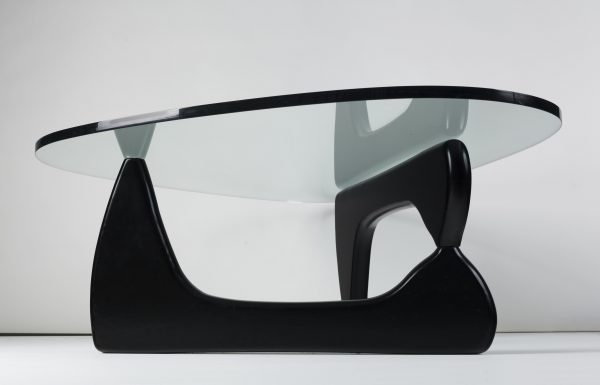
Isamu Noguchi was a sculptor, but he was so much more than that. “Choreographers and fashion designers and art directors and a whole lot of different people across a really wide creative swath look to Noguchi as a point of inspiration,” says Senior Curator at the Noguchi Museum, Dakin Hart.
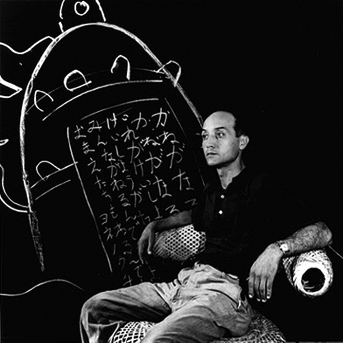
Noguchi created this museum in Queens to house a lifetime of his abstract, evocative experiments in stone and metal. Hart says Noguchi was challenging himself with every sculpture. In his later work, Noguchi’s sculptures seem to twist and balance on themselves, undulating with form and texture.
Busted Dreams
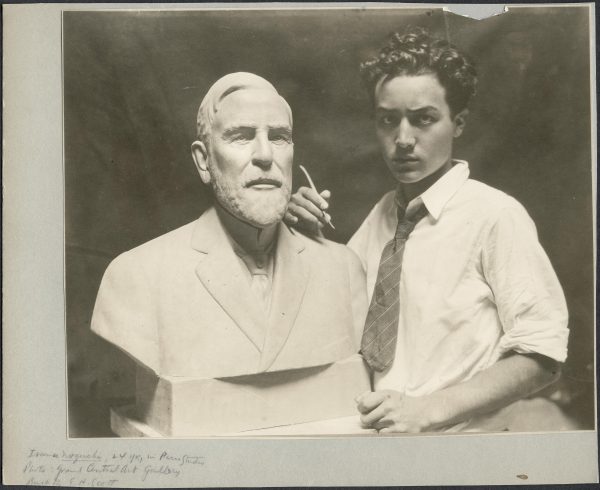
Back in the 1930s, before Noguchi had a signature museum and namesake coffee table, he was a struggling young artist in New York City. He paid the bills by sculpting busts of wealthy people. Noguchi called it “head busting,” and did this type of work to make a little money and also build up his social contacts. Noguchi was as great a networker as he was a sculptor, but head busting wasn’t exactly fulfilling. He wanted to think bigger.

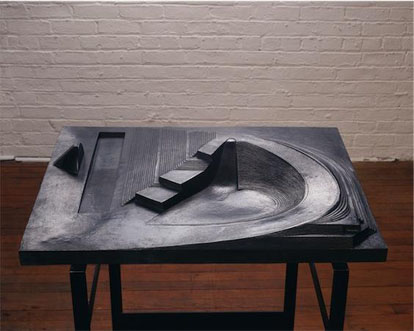
He started to think of a concept for a giant public sculpture, and in his mind, it took the form of a massive pyramid. Try to Imagine a cross between a Mayan temple and a mountain. It pushes out of the earth with a long slide sloping down with steps on two of its faces. Essentially, it’s like an asymmetrical Egyptian step-pyramid. Noguchi thought of it as a playground, and he called it Play Mountain.
Play Mountain
This giant ziggurat wouldn’t come with any specific instructions. It would have no rules and no single obvious way to play with it. Noguchi wanted Play Mountain to be a strange new landscape that would dare children to imagine other realities so that perhaps they could grow up into creative, open-minded adults. In fact, the concept for Play Mountain started for Noguchi when he was a little boy.
Isamu Noguchi was born in Los Angeles in 1904. His father Yone Noguchi was a famous Japanese poet and his mother was an American writer named Leonie Gilmour. Before Isamu was born, his father went back to Japan. Noguchi and his mother eventually followed, but by that point, Noguchi’s father had already started a new family. Leonie and Isamu Noguchi ended up moving to a countryside town called Chigasaki. Noguchi’s bright blue eyes marked him as an outsider to the other kids at school, so his childhood was pretty lonely. But from their little house, Noguchi had a great view of Mt. Fuji just like a perfect little pyramid. “…Imagine taking Mt. Fuji and turning it into a giant play structure, I think that’s what Play Mountain was,” describes Hart.
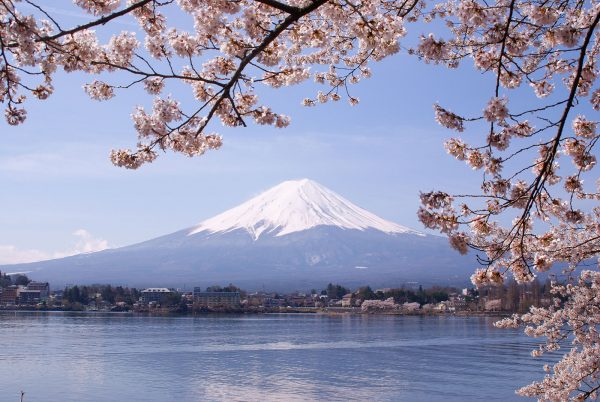
Noguchi even wrote: “Play Mountain was my response based upon memory of my own unhappy childhood — the desolate playground on a cliff in Tokyo which I approached with dread. It may be that this is how I tried to join the city, New York. To belong.” Noguchi wanted to move the mountain from his lonely childhood and reincarnate it as a place for gathering and playing as a gift to the children of New York City.
The Master Builder
In 1934, Noguchi got a meeting with Robert Moses, who was the newly appointed Commissioner of the New York City Parks Department. Moses had said his number one priority was to build more playgrounds in the city, which at the time had very few.
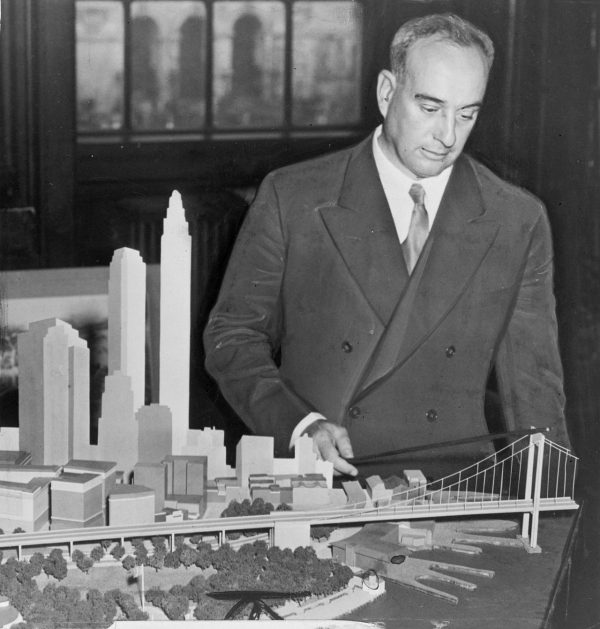
The playgrounds Moses envisioned were simple — asphalt or dirt surrounded by a chain link fence, with the Four S’s of playground equipment: swings, slide, sandbox, seesaw – all made out of steel. Moses was planning to just plonk these generic playgrounds in vacant lots all over the city by the hundreds. Noguchi’s massive, ambiguous, otherworldly urban mountain, would have required the movement of huge amounts of earth and concrete and probably would have cost a ton of money, so Noguchi’s play mountain was rejected.
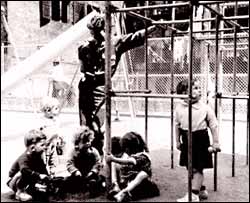
The concept of Play Mountain remained very close to Noguchi’s heart. As Noguchi himself wrote, “Play mountain was the Kernel out of which have grown all my ideas relating sculpture to the earth.” It represented this idea that Noguchi had — that children didn’t need instructions to play. With swings or a slide, there’s only one way to use them and kids just do the same prescribed activities over and over again. If you give children an abstract, surreal landscape, they will be able to interpret it however they want. This philosophy would later be called “non-directive play.” Noguchi never gave up on his design theory of non-directive play, but by then the year is 1941, and things are about to change.
Executive Order 9066
Noguchi was in California visiting a friend when he first heard the radio announcement that Japan had attacked Pearl Harbor. With the U.S. entering WWII, contoured playgrounds were forgotten by both the Parks Department and Noguchi because there were bigger stakes now.
Two months after the attack on Pearl Harbor, President Roosevelt signed Executive Order 9066 which gave the American military the right to declare martial law in any part of the country that it deemed necessary to protect the homeland. This meant that Japanese and Japanese Americans in the western part of the United States would be rounded up and removed from their homes.
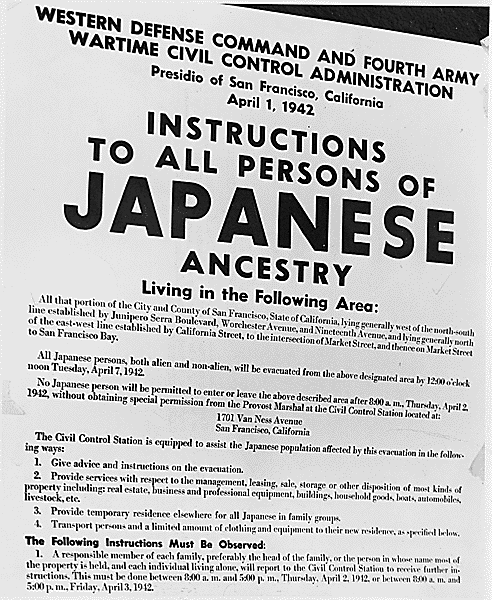
Noguchi wanted to assist in the situation, so he went to Washington D.C. to find a man named John Collier to help. Collier was the head of the Bureau of Indian Affairs. Because the government needed to build concentration camps in large, open areas of federally controlled land, they decided to build two of them on Native American reservations. This meant that the actual undertaking of building and administering these camps would fall to John Collier’s department.
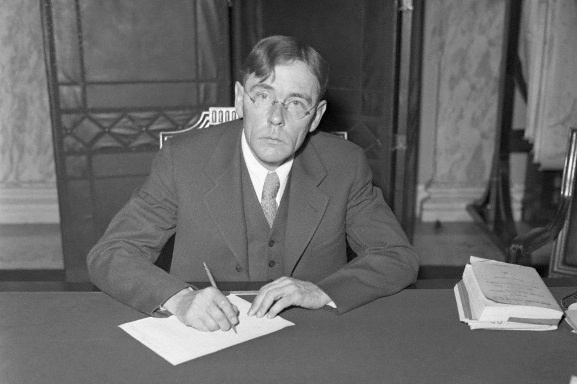
John Collier was a relatively progressive person. He wanted to give tribal governments more autonomy, protect tribal land, help build economic stability, and support Native American culture. And then suddenly he had been given the task of designing and building prison camps on reservation land. Noguchi reached out to him to talk about what they could do with this assignment since there was no way to prevent internment from happening.
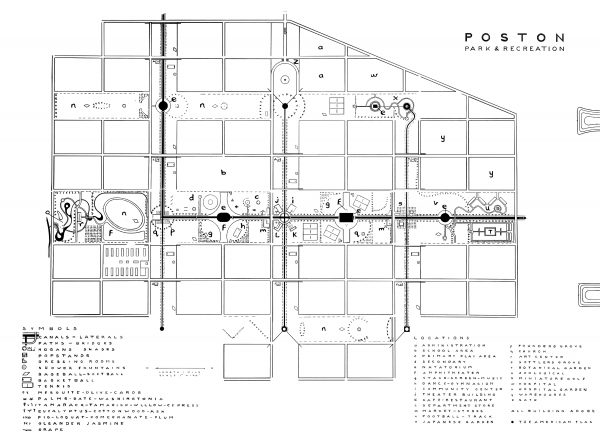
Their idea was to try to turn this into a kind of utopian project. If this was going to happen, they were going to try to make it as good as it could be. Noguchi drew up a suite of plans for the largest of the camps being built in Poston, AZ. Noguchi took the rigid grid of a military-style camp, with rows and rows of tarpaper barracks, and cut an avenue right down the middle of it, lined with public services: schools, gardens, hospitals, restaurants, a department store, a movie theater, a church, and of course, playgrounds.
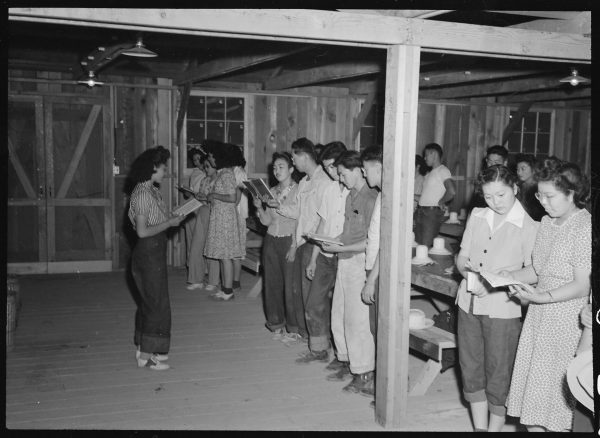
Noguchi and Collier decided that Noguchi should actually go to this concentration camp in Poston Arizona, voluntarily, and live there while he carried out his plan. The camp was being constructed in the middle of the desert, in the southwestern part of Arizona, on the Colorado River Indian Reservation.
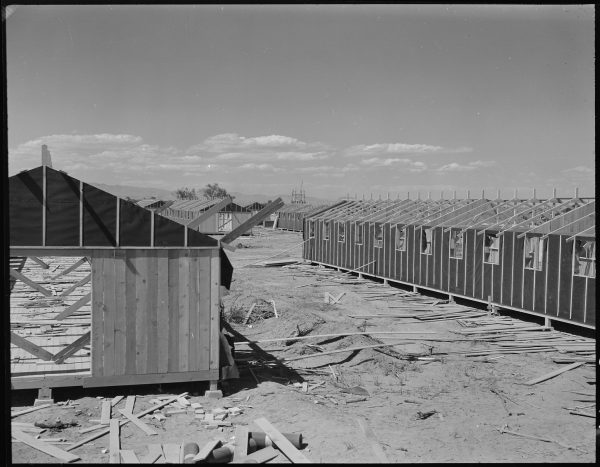
As soon as the camp opened, it became clear that the people weren’t coming there for an idyllic new lifestyle because they were prisoners. To the camp administrators from the War Relocation Authority, Noguchi looked just like another one of the prisoners. Also, because he had some special privileges, the other prisoners assumed he was a traitor in cahoots with the camp administrators.
“He immediately realized he was sort of the worst of both worlds. Because he was just an internee from the administration’s point of view, and he was a turncoat, like a spy, from the other internees’ point of view,” says Hart. After about two months, Noguchi realized that The War Relocation Authority had no interest in making Poston a nice place to live. Instead, they ran it like a prison camp and disregarded all of John Collier’s and Noguchi’s idealistic plans.
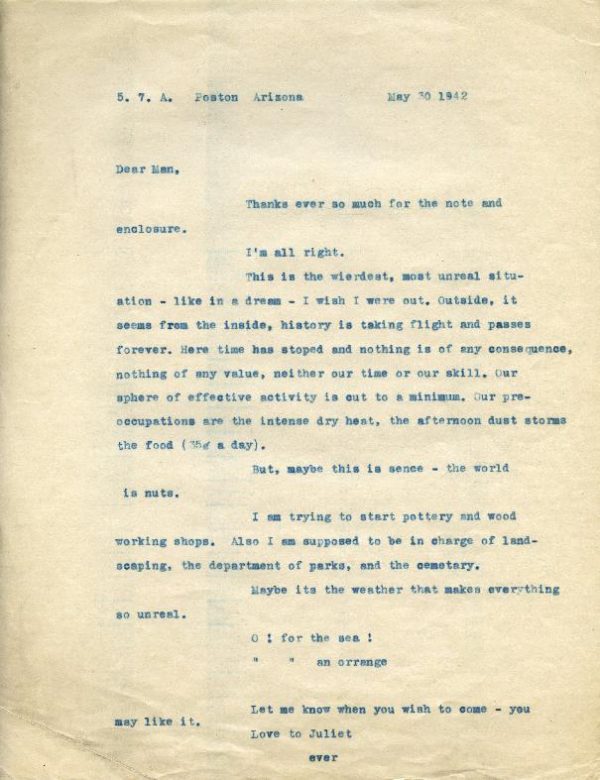
When Noguchi gave up on his vision to improve Poston, he realized he was unable to leave because of his identity as a Japanese American. Noguchi was suddenly a prisoner and had made enemies of internees and administrators alike. It took seven months, and many many letters and phone calls before John Collier was able to get Noguchi out for good.
This Tortured Earth
The whole experience was painful for Noguchi. His goals had been so compassionate going in. But racism and fear and bureaucracy killed those dreams and then imprisoned him. After Poston, the idea of designing public works and playgrounds must have seemed wrong somehow. How could you think about playgrounds when there’s so much cruelty in the world?
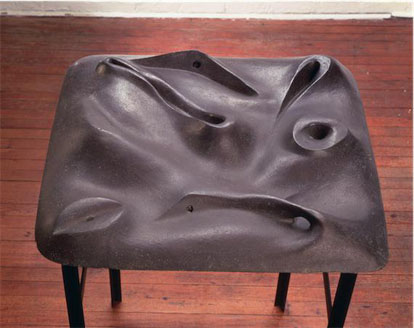
Once he was back in New York, Noguchi threw himself into the art world designing furniture and making sculptures. Noguchi stepped back from his utopian ideas about art and sculpture, and this is the period when he designed some of the things he’s most famous for today, including the iconic coffee table.
But after a decade of looking inward, indulging in the art world, Noguchi turned his sights back to playgrounds. He couldn’t shake the thought that playgrounds were the perfect way for a sculptor to make real change in the world. He tried two more times to build playgrounds for New York: once in 1950 at the new UN building, another in the early 60s in Riverside Park. These plans were even more complex and strange and wonderful than the ones before, but both were ultimately killed by the city through very long, very brutal, very public battles.
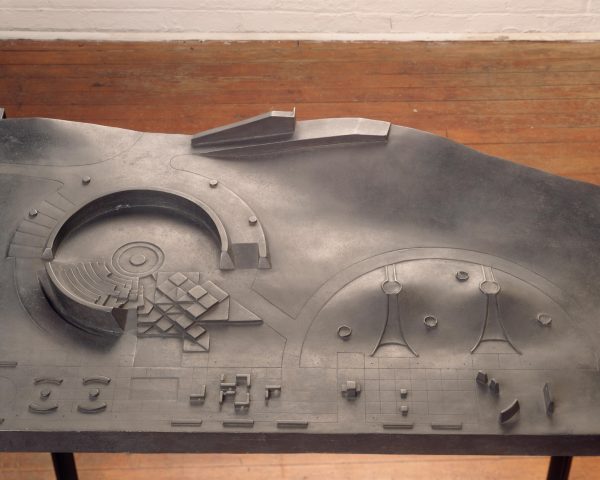
But in this round of rejections, something was different. Noguchi was now very famous and everyone in the art world had heard about all his rejected playground designs. His ideas had been written up in newspapers, and the models were displayed in museums. Other artists and architects began copying them and it became a movement of playground design called the “abstractionist” strand.
These playgrounds don’t tell you what to do. You can play with an abstract form any way you want, and imagine it as anything you like. But by the end of the 1970s, the abstract playground movement went underground because the entire world of playground design in the United States changed dramatically.
Pinched, Poked, Prodded, or Trapped
A two-year-old boy named Frank Nelson was climbing a 12-foot-tall slide in a Chicago park when he slipped through a railing and hit his head so hard that it caused permanent brain damage. The park system of Chicago was sued and had to pay out millions of dollars to Nelson’s family.
At that time, in the late 70s, there were no laws or real industry standards when it came to the safety of playground equipment. Frank Nelson’s fall was one of a number of lawsuits that led the Consumer Product Safety Commission to publish the Handbook for Public Playground Safety in 1981. Then another standards organization, the ASTM, published its own guidelines. Pretty soon these rulebooks were in the hands of insurance companies and parks departments and school boards across the United States. To this day, almost all playgrounds have to be approved by a certified playground safety inspector.
And safety inspectors look for places where kids could fall, or get pinched, poked, or trapped. As you might imagine, all of these rules and regulations make the job of playground designers a lot harder. This is the reason why the playgrounds that you see everywhere all look more or less the same. A majority of playgrounds are “post and deck” systems with standard swings, slides, and monkey bars in one piece of equipment.
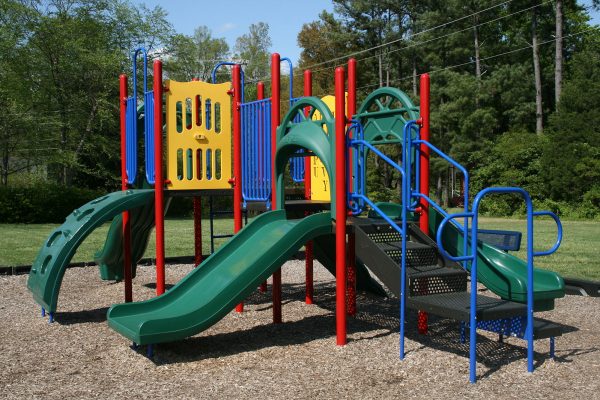
Scott Roschi is the creative director at Landscape Structures and he says the kind of abstract playgrounds that Noguchi inspired are starting to re-emerge. “Designs of today are echoing a lot of what Noguchi’s concepts were. They’re still relevant today, we’re starting to bring them back in a lot of custom playground design,” says Roschi. And this goes back to Noguchi’s concept of non-directive play, if adults are confused by a piece of play equipment, it often means kids will be all over it.
Although there are no playgrounds in New York City with Noguchi’s name on them, his ideas – about imagination, and freedom to play – have left a deep mark on playground designers, and are shaping the emerging playgrounds all around us.
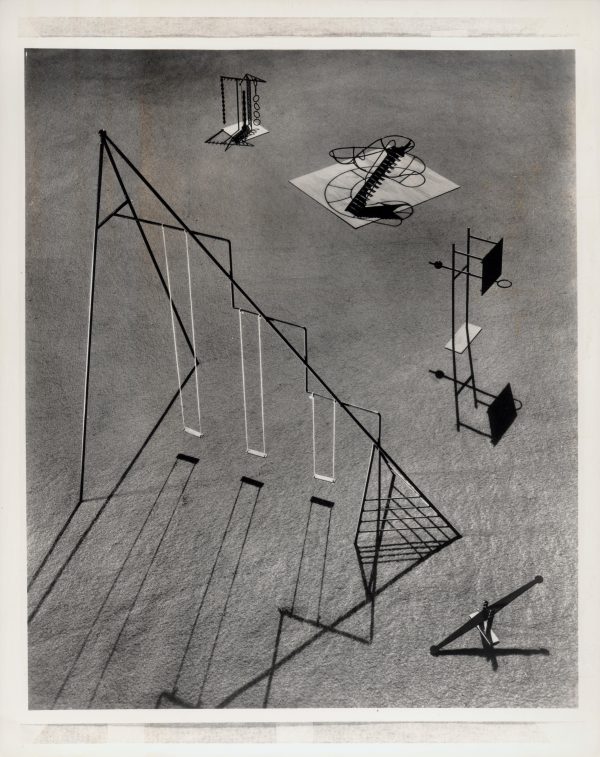
Play Mountain Realized
Noguchi’s model for Play Mountain remained on display in his Long Island City museum until January of 1988. At this point, he was 84 years old when a man from Sapporo, Japan came to visit his Long Island City museum and told Noguchi that he thought he could get one of Noguchi’s parks built in Sapporo.
Noguchi started designing play structures and earthworks for the park with his longtime collaborator, the architect Shoji Sadao. But in the winter of that year, he came down with a cold which turned into a terrible case of pneumonia that ultimately took his life shortly after. Noguchi died on December 30th, 1988, having designed the vast majority of the park. His collaborator, Shoji Sadao, continued to work on it. From Noguchi’s death at the end of 1988, Moerenuma Park took 17 years to build and finally opened in 2005.
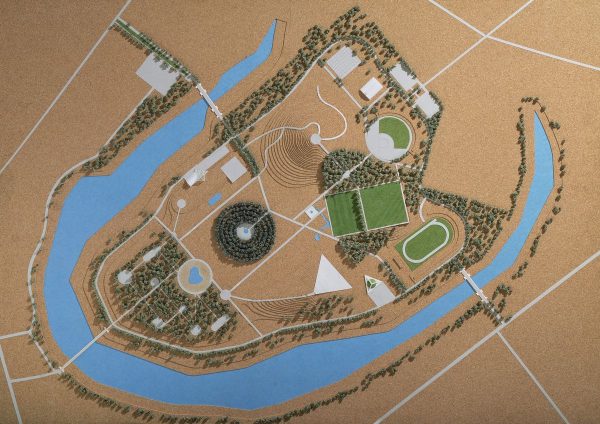
“It’s enormous … 454 acres – that’s bigger than Central Park,” says Dakin Hart. “It is kind of an amalgamation, a greatest hits, of all of Noguchi’s un-executed land and playground ideas, in one spot.” It’s this huge green swath of land, tucked into a bend in the river. There are forests of his candy-like play equipment, mounds and pyramids and swooping paths, an enormous conical hill to climb, a huge fountain that cycles through an hour-long water show.
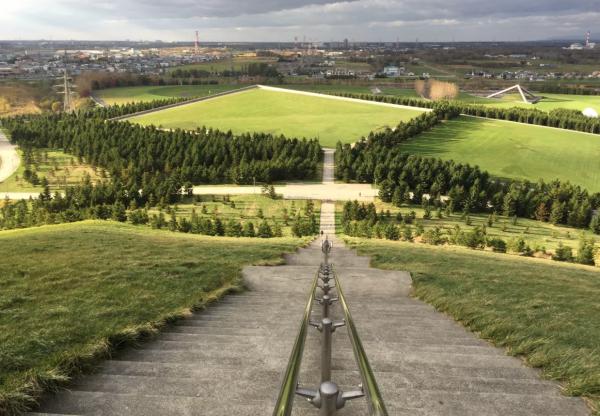
Isamu Noguchi was never able to take in the view from the peak of his creation, the sculpture he’d spent his whole life dreaming about, like a mountain teleported from the wild alien planet of his mind, the one place he ever felt he really belonged. Noguchi wanted us to see the world as if we were visiting for the first time, to move our bodies through space as if the simple facts of gravity and contour were brand new delights. He wanted us to look around with wide eyes, to feel with outstretched fingers, and to imagine infinite possibilities. In other words, he wanted us to live like kids on a playground.”

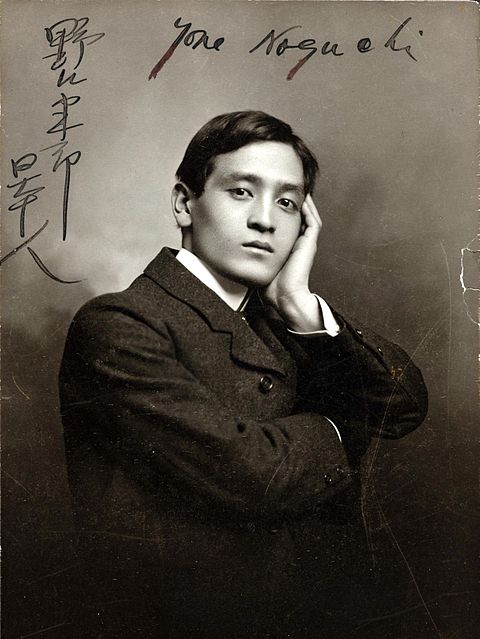



Comments (12)
Share
I was so excited listening to this episode but then so let down! I have known about the Noguchi Sculpture Garden hidden in a weird little commercial plaza in Santa Ana, CA. I totally expected you to mention it. I would like to know more about the history and what Noguchi himself thought of it. It’s enormous, open, and very interesting.
The garden seems like it follows a lot of the design intents of play mountain, even if it isn’t as large. It’s still a very large area and plays with the space well, it’s a great place to go relax and read. Here’s a link with more information and pictures: http://www.southcoastplaza.com/stories/2016/12/noguchi-garden/
This was a great story until you used the term internment camp. POSTON WAS A CONCENTRATION CAMP. You, as part of the media world, have a responsibility to use the official terminology. Please make this correction ASAP.
There is much debate about what the most accurate terminology is with many scholars having different views. There is the possibility of confusion on the part of the general public but also a need to not downplay the circumstances. Just saying “concentration camp” is not accurate enough. A good discussion is found here: https://www.npr.org/sections/publiceditor/2012/02/10/146691773/euphemisms-concentration-camps-and-the-japanese-internment
I think this short document provides good guidance.
https://jacl.org/wordpress/wp-content/uploads/2015/08/Power-of-Words-Rev.-Term.-Handbook.pdf
I would not that I have not seen much evidence of this discussion in Canada where internment is used by most survivors I know.
Excellent episode that will have me visiting Atlanta’s Piedmont Park to see the Noguchi Playscape that was referenced as the only playground designed by him and built in his lifetime.
Keep up the awesome work, y’all.
https://www.atlasobscura.com/places/noguchi-playscape
Thank you very much for talking about Moerenuma Park in Hokkaido by Noguchi. I was there last fall, and it was indeed a masterpiece. Noguchi’s life is an extremely complex and unique, and I hope that you have a chance to talk about it too sometime. https://www.amazon.com/Life-Isamu-Noguchi-Journey-without/dp/0691127824
Always read the plaque!! I was at a playground in Atlanta a few weeks ago which felt uncommon by design and I found a plaque and it is one of Noguchi’s. It is amazing how 99PI keeps connecting with my real life experiences.
I liked the episode, but there seemed to be an underlying assumption that children can’t play creatively on a slide. If you think that, you clearly haven’t seen children on slides. They don’t just march up and slide down.
I remember Play Mountain from when I was a kid, there was a great little park we would go to sometimes, and this partial pyramid stuck out of the hill like it sticks out in my mind. I don’t know its history, or who was behind the design, but I feel like Noguchi’s fingerprints all over this.
https://www.yelp.com/biz_photos/tiguex-park-albuquerque?select=sV20fmEep0T5LzChT2po_w
I have to question the assumption that traditional playground equipment doesn’t allow for imagination or creativity. My elementary school playground had a post-and-deck structure, although older with logs and steel pipe instead of plastic. However, at various times it served as a castle, a pirate ship, and a space freighter suppling a distant galactic outpost. We never felt that there was “only one way” to play with the conventional equipment (at the “space colony”, the slide was the unloading dock and the adjacent monkey bars the cargo cranes). In fact, our imagination was enhanced by a very non-generic piece of equipment: a ship’s wheel that we used to pilot our vessels.
I wonder how successful these playground designs would have been in real life. One thing I notice from Moses-era and UN designs is a lack of anything to play in or under; there is only terrain. Yet being in or under things is part of the environment both built (buildings, bridges) and natural (caves, tree canopy). The Noguchi designs seem barren. They remind me of another mid-century design for public space, City Hall Plaza in Boston, that is most notable for the absence of almost any use by the public. The post-and-deck play structures, despite being “all the same”, remind me with their human (in this case child) scale features of Faneuil Hall/Quincy Market in Boston, next to City Hall Plaza. Although not a dramatic work, Faneuil Hall is always crowded in a way the plaza is not. I wonder if Noguchi’s designs would have ended up empty like the plaza, with kids and families flocking to more traditional playgrounds elsewhere.
IWe were walking the Queens waterfront over the weekend, and stopped at Rainy Park – one of our favorites with two large hills that have a slide built into them. Instead of stairs there are rock climb grips or to hike up the slope. It’s such fun. On the walk home I realized it’s just around the corner from the Noguchi Museum. Then the next episode in my que was this one! I think this playground must have been inspired by Noguchi.
The “Post and deck” playgrounds are a horrendous design. Kids naturally start running under the structures.
Even on the picture above, you can see the sharp edges under the stairs.
( * see the two sheets holding the steps).
This is one of the areas where kids run and hit their little heads all the time.
Its time to redesign them. So glad you bring this issue.
Awesome show.